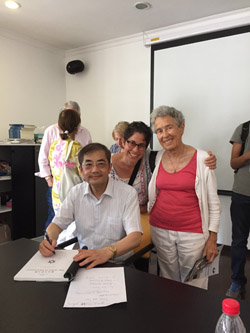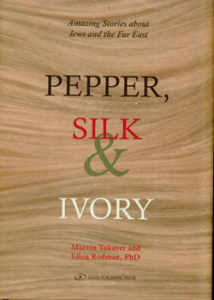By Eileen Wingard

SHANGHAI, China — In the Ohel Moshe Synagogue, now a museum, the maroon velvet curtain of the Torah Ark bears a gold embroidered inscription: “Tribute to Hongkew People Who Provided Refuge to Jews In Time of Need.” This house of worship was part of the hub of Jewish life in the ghetto in the Hongkew neighborhood of Shanghai during the years 1941-45, where some 20,000 Jewish refugees were confined by the Japanese authorities, in addition to the 100,000 poor Chinese already residing in this dilapidated area.
Jews were forced to live in overcrowded barracks with thirty to forty bug-infested bunk beds close together in a room served by two flush toilets. Cooking was outdoors on hibachi-like wood stoves. Privacy was non-existent. However, the indigenous Chinese proved to be respectful and neighborly. They had suffered massive killings in the Sino-Japanese war and empathized with the refugees.
The area became known as “Little Vienna,” because, in spite of the adverse conditions, the Jews managed to create schools, newspapers, lecture series, concerts, sports teams and even coffee houses.
Although the Japanese authorities were strongly pressured by their Nazi allies to set up concentration camps and death camps—Colonel Josef Meisinger, known as the Butcher of Warsaw, was sent to oversee those “final solution” operations—the Japanese authorities, to their credit, resisted those pressures. However, they did create the ghetto, what they termed, “Designated Area for Stateless Refugees,” ordering all refugees who had arrived in Shanghai from Europe after 1937, to move within its parameters.
With a Chinese guide and our venerated tour leader, Rabbi Marvin Tokayer, our 41-member tour group learned a great deal about the ghetto. In addition, we visited the Center for Jewish Studies Shanghai (CJSS) where we heard a fascinating power point presentation on the Jews of Shanghai by Professor Pan Guang, Dean of the CJSS and the leading authority on the subject.The Center is housed within the campus of the Shanghai Academy of Social Sciences.
Established in 1988, the CJSS coordinates research activities on Jewish and Israeli Studies and actively collaborates with scholars from around the world, publishing books, sponsoring exhibits and conferences and introducing Hebrew teaching for school children. They have also supported documentary films and television productions on Jews in China, especially in Shanghai.
The Jews came to Shanghai is several waves. In the mid-19th century, came the first wave, made up of Jews from Baghdad, most prominently the Kadoori Family, known though their banking as the Rothchilds of the East, and the Sasoons, who established a branch of their import-export business. These families invested in real estate, manufacturing, and public utilities, and became very wealthy. We visited the Marble Hall, home to Sir Elly Kadoorie from 1924-1949, now known as the Children’s Palace, and housing a school for gifted and talented children. This palatial edifice had an enormous front lawn where, on Sukkot, the Kadoories had a sukkah built to accommodate 300 guests.
Victor Sasoon’s family built an impressive hotel, now called the Peace Hotel, whose green pyramid roof is a landmark on the Bund, the commercial center of the city on the banks of the Huangpu River. Inside, off its magnificent lobby, whose wood paneled walls, marbled floors, and glistening chandeliers reminded me of the King David Hotel in Jerusalem, there was a museum. In the museum were photos and memorabilia depicting the history of the hotel. Many photos showed a dapper-looking Victor Sassoon hosting celebrities from around the world, such as Marlene Dietrich, Charlie Chaplin and Paulette Godard.
Across the river on the Bund were many recently-built skyscrapers, including the Shanghai Tower, which, at 2,073 feet, is the tallest building in all of China and the second tallest in the world.
The second wave of Jews who came to Shanghai were escapees from the pogroms of Russia. They came in the early 1900s. They were much poorer than the Baghdadi Jews and became shopkeepers. In the middle of the 1930’s, the Jewish community numbered 5000.
With the advent of the Nazis in Europe, and Shanghai one of the only places allowing Jews in without visas, a third wave of Jews arrived, and the Jewish population swelled to over 30,000. Many were penniless, unable to bring anything with them other than the clothes on their backs.
Thanks to the philanthropy of the wealthier Jews of Shanghai and the Joint Distribution Committee, the refugees managed to survive the war. One of the Chinese diplomats who issued visas to allow Jews to exit Austria was Dr. Feng Shan Ho. He is memorialized in Yad Vashem’s Garden of the Righteous.
In this city of 25 million, often called the Paris of the East, our group visited the Shanghai Museum with its vast collection of exquisite art and antiquities. We toured a silk factory, and attended a spectacular performance of the Chinese Acrobatic Circus. Shabbat dinner was provided by one of the three existing Chabad locations in Shanghai, with an energetic Israeli rabbi leading the services and hosting the kosher, four-course feast.

On our last afternoon in Shanghai, we met to reflect on our trip, which explored the Jewish presence in the Far East. We marveled at all we had learned and experienced during our two weeks. We felt lucky to be led by Rabbi Tokayer, who spent 20 years as the rabbi in Tokyo, during which he served the entire Far East. One need only read his recent book, Pepper, Silk and Ivory, to realize his extensive knowledge and his marvelous gift of storytelling. Our group felt particularly fortunate because this was the last trip he intends to lead. At 79, he wants to devote his time to writing his memoirs and lecturing.
The San Diego Center for Jewish Culture will be presenting Rabbi Tokayer in two lectures as part of Yom Limmud this Sunday, August 30 at the Lawrence Family JCC. At 9 a.m., he is scheduled to speak on China, Mongolia and Manchuria: The Unknown Jewish Experience, and at 1 p.m., he will be speaking on Jews and India: The Most Benevolent Jewish Diaspora Experience. Those attending will get a taste of what we 41 participants enjoyed on our tour, Japan and China Through Jewish Eyes.
*
Wingard is a freelance writer who specializes in the coverage of the arts. You may contact her via eileen.wingard@sdjewishworld.com
Pingback: Freelance Tour Guide China | Cheap Tour
Pingback: China Jewish Tour | Cheap Tour
This comment came from Leonard Weiss of Roslyn, N.Y., for Eileen Wingard: “Your articles are really interesting. They tie in with our trip. With Rabbi’s retiremen , you probably could take over the tour.
Pingback: Tour Guide In Shanghai China | Tour Deal